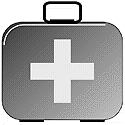

Clarion Health, located in Indianapolis, Indiana, is the result of a recent merger among Methodist Hospital, Indiana University, and Riley Hospital. It is the second-largest and seventh-busiest private hospital in the United States. Clarion Health houses a large network of primary care physicians, specialty physicians, outpatient centers, and affiliates throughout the state of Indiana who treat more than 45,000 admissions a year.
Presenting problem Clarion Health sought a high-performance, cost-effective, and secure way to deploy mission-critical Electronic Signature and SoftMed applications to approximately 500 physicians and staff members in area locations over low-bandwidth dial-up connections. These applications enable physicians to sign for patient medical records remotely. Since the applications contain confidential patient information, they require central management and deployment to ensure the highest security.
The challenge: Deploy mission-critical applications to physicians and other health care providers.
Before implementing the thin-client/server solution, Clarion Health accessed mission-critical applications over remote-node connections. Under this approach, application processing occurs on the remote workstation, and actual files are transmitted over telephone lines. Remote-node solutions tend to suffer performance problems when large amounts of data, such as database information, must be accessed over low-bandwidth connections.
The remote-node solution also required one dedicated PC for every dial-in line supported. The IS director quickly realized that this method of remote access would be prohibitively expensive and would require heavy maintenance. The IS director also found the clustered-CPU alternative too costly. (Clustered-CPU products provide a hardware platform for stand-alone remote-control software.)
Hardware and software The Clarion Health thin-client/server networking environment includes:
Clarion Health deploys Electronic Signature and Soft-Med applications.
The Clarion Health thin-client/server solution uses the WinFrame server to deploy its Electronic Signature and SoftMed applications.
Solution and results Clarion Health installed several WinFrame application servers to deploy its mission-critical applications to approximately 500 physicians and staff members in area locations over low-bandwidth dial-up connections.
The strategic implementation of this thin-client/server solution has resulted in greater physician efficiency and productivity by arming doctors with 24-hour access to patient information. Busy physicians and staff employees now have secure, real-time access to mission-critical information, regardless of whether they’re located in an office that’s part of the LAN or if they’re out and accessing the software through a low-bandwidth connection.
Clarion Health now has greater physician efficiency through 24-hour access to patient information.
The Clarion Health Information Technology (IT) group reported that the thin-client/server solution using WinFrame exceeded their response-time criteria for dial-up connections. The solution also allowed them to leverage Clarion’s existing technology by working with the available remote access and communications infrastructure. And finally, it offered the centralized support, security, and application management for remote users so valued by many of the other companies you’ve read about in this chapter.
Clarion Health employees dial into the network through its NetBlazer remote-node server. The WinFrame server back-ends the remote-node server to execute applications on the high-bandwidth LAN. Only the user interface is sent across the wire, significantly enhancing remote application performance.
Because of its highly confidential medical environment, Clarion Health added an additional layer of security to WinFrame’s stringent Microsoft Windows NT Server–based system through the use of Security Dynamics’ ACE/Server and SecurID identification and authentication software. SecurID provides dynamic, two-factor authentication that combines a personal identification number (PIN) with a randomly generated access code that changes every 60 seconds. To access a SecurID-protected WinFrame server, users are challenged by both WinFrame security and the SecurID token passcode security. Once authenticated, users can log on to a WinFrame application server.
The thin-client/server solution using WinFrame has simplified system administration and maintenance for Clarion’s IT organization, enabling the IT staff to solve system administration issues remotely as well as to support remote users conveniently from a central location—the WinFrame application server.
Initial deployment of the thin-client/server solution improved the outpatient center’s response time tremendously. Following this initial success, other departments in the hospital plan to use Win-Frame to deploy mission-critical applications, such as financial and human resources applications.